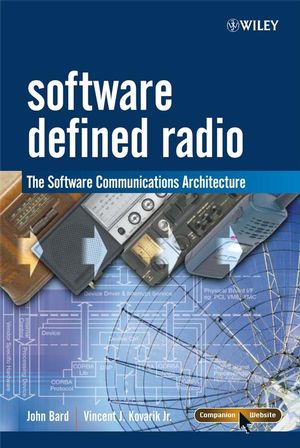Software Defined Radio: The Software Communications ArchitectureISBN: 978-0-470-86518-7
Hardcover
440 pages
April 2007
 This is a Print-on-Demand title. It will be printed specifically to fill your order. Please allow an additional 15-20 days delivery time. The book is not returnable.
|
||||||
Foreword.
Preface.
Audience.
Scope.
Conventions Used in this Book.
Organization.
Additional Material and Author Contact.
PART I The Operating Environment (OE).
1 Introduction.
1.1 Software Radios.
1.2 The Software Communications Architecture.
1.3 The Operating Environment.
1.4 The SCA Specification Structure.
1.5 Summary.
2 Operational Scenarios.
2.1 Startup.
2.2 Shutdown.
2.3 Application (Un)Installation.
2.4 Instantiate Application.
2.5 Control Application.
2.6 System Configuration.
3 General Requirements and Services.
3.1 Non-Functional Requirements.
3.2 Name Service.
3.3 Event Service.
3.4 Log Service.
3.5 FileSystem.
3.6 File.
4 Foundation Interfaces and Data Types.
4.1 TestableObject.
4.2 PortSupplier.
4.3 LifeCycle.
4.4 PropertySet.
.5 Resource.
4.6 ResourceFactory.
4.7 Port.
5 Devices and the Device Manager.
5.1 Introduction.
5.2 Device.
5.3 LoadableDevice.
5.4 ExecutableDevice.
5.5 AggregateDevice.
5.6 DeviceManager.
6 Domain Management.
6.1 DomainManager.
6.2 FileManager.
6.3 The ApplicationFactory.
6.4 Application.
7 Operating Environment Security.
7.1 Core Framework Security Requirements.
8 Certification.
8.1 Certification Process.
8.2 Operating Environment Certification.
8.3 Waveform Assessment and Certification.
PART II The Domain Profile.
9 The Domain Profile.
9.1 Overview.
9.2 SCA Domain Profile XML.
9.3 Domain Profile Data Types.
10 Base Descriptor Files.
10.1 Properties Descriptor.
10.2 softpkg.
10.3 Software Component Descriptor.
10.4 Device Package Descriptor.
11 Device Configuration Descriptor.
11.1 Overview.
11.2 deviceconfiguration.
12 The Domain Manager Descriptor.
12.1 Overview.
13 The Software Assembly Descriptor.
13.1 Overview.
PART III Building an SCA-Compliant System.
14 The POSIX Operating System.
14.1 An Operating Environment.
14.2 Linux 2.6 Kernel.
15 POSIX Threads.
15.1 The Thread Object.
15.2 Un-named Semaphores.
15.3 Mutex Variables.
15.4 Thread Attributes.
15.5 Conditional Variables.
15.6 Less Interesting Thread Calls.
16 All ORBS are not Created Equal.
16.1 CORBA Basics.
16.2 The Object Management Group.
16.3 ‘C’ ORB versus C++ ORBs.
16.4 Initial Services.
16.5 The Interface Repository.
16.6 Minimum CORBA.
16.7 The Portable Object Adapter (POA).
16.8 Real-time CORBA.
16.9 Overview of Available ORBs.
17 The Services.
17.1 Interoperable Naming Service.
17.2 Event Service.
17.3 Log Service.
18 Exploring the Domain.
18.1 Application Factory Attributes.
18.2 Application Attributes.
18.3 DeviceManager Attributes.
18.4 Device Attributes.
18.5 AggregateDevice Attributes.
18.6 DomainManager Attributes.
18.7 Properties.
18.8 Manipulating Ports.
18.9 Summary.
19 An SCA-compliant Application.
19.1 Hello World Legacy Application.
19.2 Legacy Hello World SPD.
19.3 HMI Applications.
19.4 Shutting Down.
19.5 An SCA-compliant Hello World Application.
Appendix A Mandatory POSIX Calls.
Appendix B References to Part III.
Index.



